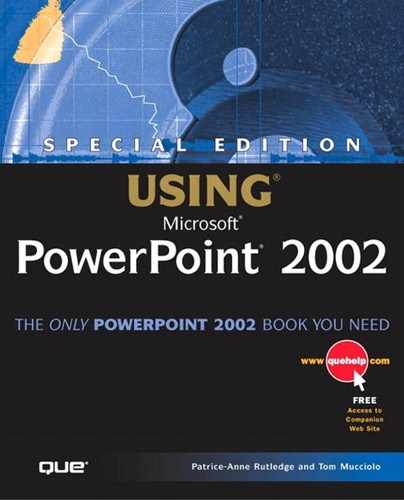Using Toolbars
A toolbar is similar to a menu because it categorizes related commands to make it easier for you to perform a specific task. Toolbars use a graphical representation, or button, rather than a menu-based text representation. Even though toolbars use buttons rather than text, you can still display a text description of what the button does by pausing the mouse over it. A ScreenTipappears, identifying the button's function. Figure 1.5 illustrates a ScreenTip.
Figure 1.5. ScreenTips identify toolbar buttons.

ScreenTips don't appear? See the“Troubleshooting” section near the end of the chapter.
The Standard and Formatting toolbars are the two most commonly used PowerPoint toolbars. Table 1.1 describes the buttons on the Standard toolbar, which you'll use frequently in PowerPoint.
Note
You can switch between displaying the Standard and Formatting toolbars on either two rows or one with the Show Standard and Formatting Toolbars on Two Rows check box on the Options tab of the Customize dialog box. Open this dialog box by selecting Tools, Customize. Although it's usually easier having access to all these buttons on two rows, you might want to combine these toolbars if you want to save screen space.
→ To view a table of the buttons on the Formatting toolbar, see “Using the Formatting Toolbar” in Chapter 3, “Working with Text.”
Displaying Toolbars
To open and close toolbars manually, choose View, Toolbars and then select or deselect toolbars from the list of available options. Figure 1.6 illustrates this menu and the available toolbars.
Figure 1.6. Select a toolbar from this menu to display it.

→ To learn how to customize and modify PowerPoint toolbars to fit your needs, see “Customizing Toolbars” in Chapter 21.
Moving Toolbars
You can easily move a toolbar to a new location. How you do this depends on whether the toolbar is dockedor is floating. Figure 1.7 illustrates both types of toolbars.
Figure 1.7. You can move PowerPoint toolbars to make the program easier to use.

To move a docked toolbar, drag the move handle on its left side to a new location. To move a floating toolbar, drag its title bar. You can easily switch a toolbar from docked to floating and vice versa. Drag a docked toolbar to another location on the screen to float it. Drag a floating toolbar to the edge of the window to dock it.
Tip from
You can resize a floating toolbar by dragging on any side. This way you can display the buttons straight across in one row or in several rows, depending on which way it's easier to view your presentation.
Can't find a toolbar button you've used before? See the “Troubleshooting” section near the end of the chapter.
